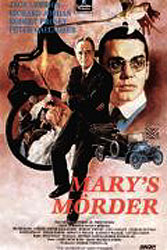 Unusually well acted for a telefilm/mini-series, Emmy Award winning The Murder of Mary Phagan (1988) was rather too earnest to feel quite so serious as it is played. It is based on a true story of the murder of a thirteen year old pencil factory worker in 1913 Atlanta, Georgia. With liberties of historical fact, it takes a certain point of view, as the message is more important than accuracy.
Unusually well acted for a telefilm/mini-series, Emmy Award winning The Murder of Mary Phagan (1988) was rather too earnest to feel quite so serious as it is played. It is based on a true story of the murder of a thirteen year old pencil factory worker in 1913 Atlanta, Georgia. With liberties of historical fact, it takes a certain point of view, as the message is more important than accuracy.
This story was once before filmed as the intensely dispiriting They Won't Forget (1937), though the issue of Jewish bigotry was removed. And in spite of the title, in fact the case was largely forgotten, so the 1988 telefilm's heart was in the right place.
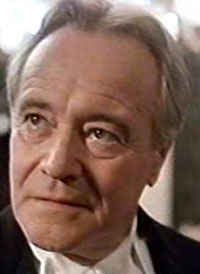 This event was the pivotal moment for the rebirth of the Ku Klux Klan, united to drive the Jews out of Cobb County, Georgia; & it is important that such things be restored to public memory now & again. This event was the pivotal moment for the rebirth of the Ku Klux Klan, united to drive the Jews out of Cobb County, Georgia; & it is important that such things be restored to public memory now & again.
But the fact that this telefilm inspired the Broadway musical Parade (1997) pretty much comments on the weaknesses of the film, as it wouldn't've been out of place to have these overly emotional actors put hands to heart & caterwaul diddies of the injustices & hatreds such as abound in American society to this very day. Sometimes melodrama isn't the best option if dramatic effect, rather than a burlesque of dramatic effect, is the intended goal.
Much of the second half of the film is straightforward courtroom drama, resulting in an innocent man (Peter Gallagher) convicted of the crime largely because he is a Jew & a northerner, not from credible evidence.
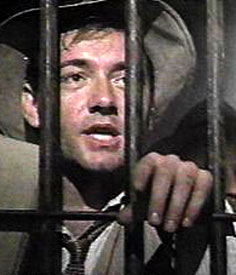 Governor John Slaton (Jack Lemmon) destroys his political career by commuting a death sentence to life imprisonment, & has to leave Georgia due to the fall-out of sparing the life of a man who is apparently innocent. The public still wants Jewish blood, & a lynching party prepares for the film's climax. Governor John Slaton (Jack Lemmon) destroys his political career by commuting a death sentence to life imprisonment, & has to leave Georgia due to the fall-out of sparing the life of a man who is apparently innocent. The public still wants Jewish blood, & a lynching party prepares for the film's climax.
An incredible array of supporting cast populate this epic (William H. Macy, Kevin Spacey, Cynthia Nixon, Loretta Devine, many others you'll recognize by face even if not by name). But very few have much to do that isn't rather like puppetry or author commentary.
If the "message" reaches the individual viewer, the film may seem very fine indeed, as it almost justifies its length (over four hours). But it could've been so much stronger as a tighter feature film & a little less handwringing & whinging. Sometimes the cool costumes & architecture (of Petersburg, Virginia, rather than Atlanta) is more interesting than the heroes & villains of the piece.
It's such a simple straightforward tale of bigotry in America, & insists so strongly on its moral lessons, that it ends up being too mawkishly instructive to take seriously, despite the seriousness of the performances. And Peter Gallagher as Leo Frank plays it so dough-eyed that he comes off more as a wronged puppy rather than a wronged man.
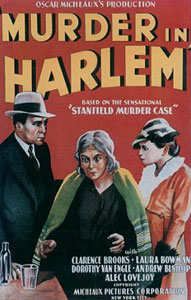 The Frank case was also the inspiration for black independent filmmaker Oscar Micheaux in his silent film The Gunsaulus Mystery (1921).
The Frank case was also the inspiration for black independent filmmaker Oscar Micheaux in his silent film The Gunsaulus Mystery (1921).
The film does not survive, but an outline of its plot is known. Micheaux changes all the conditions of the case, in that the murdered white child is here a black woman.
An innocent black man is charged with the murder, but ultimatey proven innocent because a perverted white man (which is his way of saying "a Jew") did it.
Micheaux later re-adapted the story with sound as Murder in Harlem (1935), sometimes listed with alternative titles Lem Hawkins' Confession & Brand of Cain (1935). It was for decades thought to be another lost film, but a print turned up in Texas warehouse in 1983.
This time the white child is a white woman, so Micheaux can make clearer race observations.
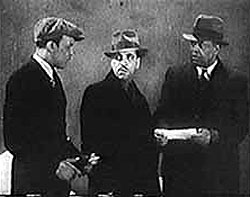 He has quite an axe to grind, disdainful of the evidence (rather good evidence unfortunately) that the crime was actually that of a black janitor at the pencil factory. He has quite an axe to grind, disdainful of the evidence (rather good evidence unfortunately) that the crime was actually that of a black janitor at the pencil factory.
It was a poor case to adapt to his point of view, & many other cases of wrongly lynched black men could've been used, rather than a case that in reality showed that if anyone was more deeply hated than negroes in the south, it'd be a yankee Jew.
Historically speaking, the janitor was discovered trying to destroy a bloodsoaked shirt & really is the most likely candidate for guilty party.
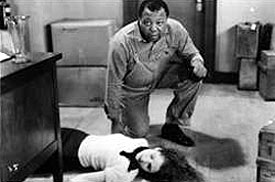 After changing his story a couple times, he settled on the claim that the Jew forced him to clean up after he killed the girl. The prosecuting attorney liked this theory, as many leading politicians were busy assaulting the Jewish community at the time. After changing his story a couple times, he settled on the claim that the Jew forced him to clean up after he killed the girl. The prosecuting attorney liked this theory, as many leading politicians were busy assaulting the Jewish community at the time.
In The Murder of Mary Phagan this character is played by Charles Dutton. In Micheaux's film he's played with bizarre relish by Alec Lovejoy.
Micheaux might well be forgiven for thinking that the murder of a white girl by a black man simply had to be nothing but the easiest scapegoat situation. But he had to change every damned fact of the case to make it look plausible this time. Not that Lem is treated as a hero. He's dispicable Uncle Tom. Still, he's innocent, & his happy ending is a poor one for historicity.
copyright © by Paghat the Ratgirl
|
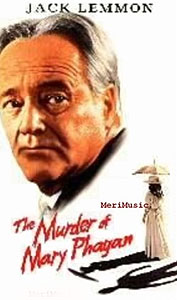

 This event was the pivotal moment for the rebirth of the Ku Klux Klan, united to drive the Jews out of Cobb County, Georgia; & it is important that such things be restored to public memory now & again.
This event was the pivotal moment for the rebirth of the Ku Klux Klan, united to drive the Jews out of Cobb County, Georgia; & it is important that such things be restored to public memory now & again. Governor John Slaton (Jack Lemmon) destroys his political career by commuting a death sentence to life imprisonment, & has to leave Georgia due to the fall-out of sparing the life of a man who is apparently innocent. The public still wants Jewish blood, & a lynching party prepares for the film's climax.
Governor John Slaton (Jack Lemmon) destroys his political career by commuting a death sentence to life imprisonment, & has to leave Georgia due to the fall-out of sparing the life of a man who is apparently innocent. The public still wants Jewish blood, & a lynching party prepares for the film's climax. The Frank case was also the inspiration for black independent filmmaker Oscar Micheaux in his silent film The Gunsaulus Mystery (1921).
The Frank case was also the inspiration for black independent filmmaker Oscar Micheaux in his silent film The Gunsaulus Mystery (1921). He has quite an axe to grind, disdainful of the evidence (rather good evidence unfortunately) that the crime was actually that of a black janitor at the pencil factory.
He has quite an axe to grind, disdainful of the evidence (rather good evidence unfortunately) that the crime was actually that of a black janitor at the pencil factory. After changing his story a couple times, he settled on the claim that the Jew forced him to clean up after he killed the girl. The prosecuting attorney liked this theory, as many leading politicians were busy assaulting the Jewish community at the time.
After changing his story a couple times, he settled on the claim that the Jew forced him to clean up after he killed the girl. The prosecuting attorney liked this theory, as many leading politicians were busy assaulting the Jewish community at the time.